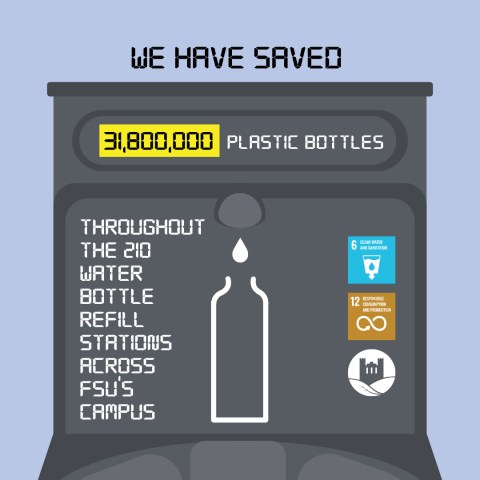Campus Wide Water Refill Data Collection

There are over 200 places on the main campus of Florida State University to refill your water bottle, coffee pot, mug, or other vessel that requires drinking water. Each of these water bottle refill stations is either from the brand Elkay or Brita. From the two brands, there are also subcategories of a single refill station or a hilo refill station. A single station may be either brand and means there is one refill station above a regular water fountain. A hilo station may be either brand, but there is one refill station above two, connected water fountains. On the top part of the refill station, there are three things to note. First, there is the brand of the refill station, second, there are three different colored circles that light up and indicate the filter status, and lastly a digital number of water bottles saved from landfill according to the usage of the refill station.
According to the Elkay website, the size of one water bottle is 20 fluid ounces. So, for every one bottle of water that is saved from landfill, that is the equivalent of 20 fluid ounces as the standard size. Knowing this standard, this is why if one is filling up their water bottle that may be less than 20 fluid ounces of liquid, the number of water bottles may increase by one because the ounces threshold was passed. Similarly, if someone has an extremely large water bottle, the liquid may be the equivalent of 2 water bottles saved from landfill because there were over 40 fluid ounces of water used. To accomplish the collection process, the data was collected through two distinct phases.
This wide-scale data collection process took place across two phases. The first phase occurred in early spring 2024 with the help of around 13 volunteers who signed up to visit specific buildings and collect the data via a Microsoft Form. The second phase occurred over summer 2024 with the help of around 9 Sustainable Campus staff members. Some individuals were able to visit multiple buildings which is extremely helpful across the collection period, contributing to the success of capturing 81 buildings.
The intention behind this project was to start the benchmark standard of data across all the water bottle refill stations since their installation. As the stations were installed, each station started with a digital count of zero water bottles, the filter status was green, and the machines were clean. Through this process, multiple vital pieces of information were to be collected such as the status of the water bottle station, if repairs are needed, the opportunity for more stations within a building, and ultimately the number of water bottles saved from landfill.
There were a few standouts academic buildings that had impressively high usage of water bottle refill stations. In Strozier library, on the third floor, there was one refill station that noted over 77,000 single-use bottles were saved from landfill. Hats off to studying students for bringing their refillable water bottles to this station! In Dirac library, on the fourth floor, there was another station that noted over 215,000 bottles saved from landfill! Over a quarter of a million bottles were saved thanks to these refill stations strategically placed in locations where there are lots of studious students and access to clean water.
Lastly, this collection process included many different types of buildings across campus such as academic, administrative, and recreational spaces. This exploration and collection process revealed that there were precisely 33,147,558 water bottles saved from landfill thanks to the refill stations. Over 33 million single-use plastic bottles were diverted and captured via these stations instead. Each one of these water bottle refill stations contributes to reducing waste across campus, encourages reusable vessels, and provides clean drinking water to all students, faculty, community members, and staff.

